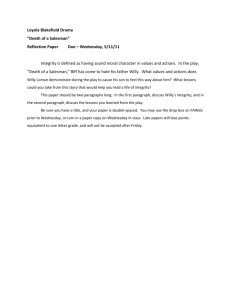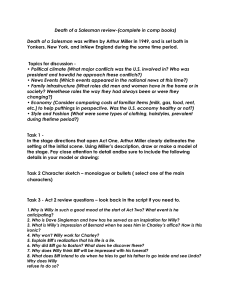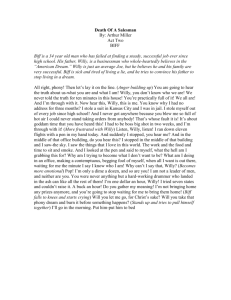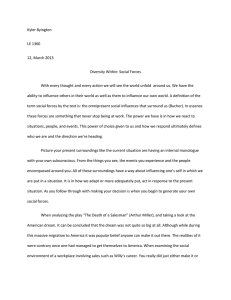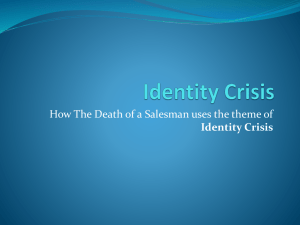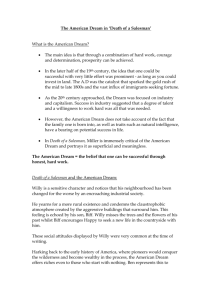The Death of a Salesman
advertisement
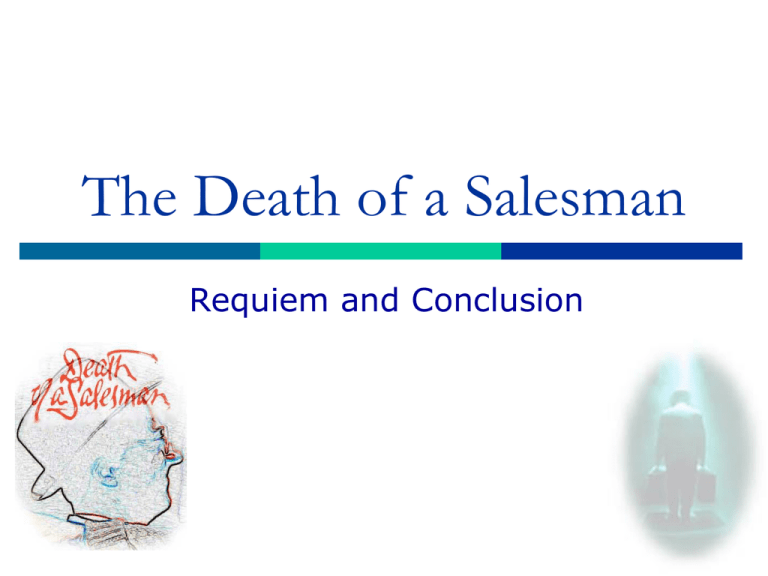
The Death of a Salesman
Requiem and Conclusion
Outline
Discussion Questions
The Requiem:
Arthur Miller’s “Tragedy and the Common Man”
Willy’s “tragedy”:
Different Views of Willy Loman
The Survivors
The Work of the Environment
His Character
Different Kinds of Success
Critique of The American Dream
The Play as an Example of Expressionism
Final Exam, Spring 2015 & Course Evaluations
Discussion Questions
1.
2.
3.
4.
5.
6.
7.
8.
G4: What do you think are the functions of
Requiem?
G8/ G10: Is Willy Loman a tragic hero who acts
and wins our esteem? Or is he a victim? A victim
of his own character or of a system of exploitation
and ruthless competition?
G6: How about the other Loman characters’
Dreams?
G7: Why is this play an example of Expressionism?
(consider it’s stage and stage directions)
G9: The play as a critique of the American Dream?
G2: Questions posed on journal 4
G3: Hot Seats
G5/G1: The Road Better Taken
Journal Answer Types
Questions
Suicide -- An escape or ending his selfdeception
-- Guilty or not
American Dream & Social Conditions
Willy/Biff vs. Charley/Bernard
Biff vs. Happy
Symbols (car, woman and rubber tube)
Willy’s dream vs. the others’
Linda’s tolerance
Ms. Francis (1723-1725), walks out
purposely?
Respondents
Sharon, Joy, Freddy,
Miffy, Annie, Tracey, ….
Sharon
Ronnie
Alston
Janeen
Joy, Ginger
Andrea
Questions: 1) Ben--time? 2) Similar experience as Biff’s or Happy’s in
their relation with their father?
3) What would you do if you were Willy’s friend? 4) why salesman? 5)
many others
Errors:
Happy’s dream is not on the farm; subjunctive mood
More Creative Questions:
(1) “The Road Not Taken”
(2) Salesman’s Sample Case
(3) A News Story
(4) Happy, Biff or Linda, taking
the hot seat
More Creative Questions:
(1) “The Road Not Taken”
-- Persuade Willy or Biff to make a
different choice at one of the
character’s various turning points,
while showing how you understand
him in his original choice.
Willy: w/o Self-Knowledge & Self-Acceptance
w/ fatherly love & pride
3. Biff’s
rejecting
him
Willy
Guilty
about
Linda
Father?
For Ben,
2. Woman
4. Rejecting
Charley
In Conflict
w/ Biff but
loving him
5. Committing
Suicide
Single-man
Against
Charley
Keeping
empty
dreams
1. Not
successful
Biff w/ talents in sports, interests in farm work,
love for his father & [towards the end] self-knowledge
w/o abilities to resolve conflicts in his life, w/ his father, or
how to succeed in biz
Biff
1) A Sports
Star but
stealing
Flunked math
2) Stealing
out of
different jobs
Finds
himself
wasting life
IN jail for 3
months
3) Goes to Bill
Oliver but steals
from him
Works at
different
farms
4) Walks off
Burning
snickers
5) Confesses
to his father
Woman
Tell him
sth nice
More Creative Questions:
(2) Sample Cases
Myth & Charisma
Image
source
What would you carry in your
case if you were a salesman in
1940’s or today? How would you
sell them, supporting the myth or
revealing their contradictions?
Possible items: 1950’s – silk
stockings (femininity), home
appliance (for nuclear family);
Today: cosmetics, cell phones;
suitcase turned into a blog, or a
hand-held ad (for real estate)
Issues
Consumerism, Sweet Home
Dream in the 50’s
Consumerism, Economic
Inequality & Competitive
Capitalist System today (ref)
More Creative Questions:
(3) Headline News
After the death of Willy, you, a
journalist, interview his boss,
customers and family and write
a news story about why he
died.
News representation --indifferent,
intrusively sentimental, analytical, or
elegiac?
More Creative Questions:
(4) Hot Seat
You take the role of either Linda
(Jean), Biff (Zoe) or Happy
(Rita), stay in the character and
get quizzed by your classmates.
Requiem –formal, somber, a-temporal
Stage Direction: (the only transition from car
crash to Requiem)
Music: a frenzy of sound A single cello string a dead
march;
Lighting: leaves and daylight.
Wall-line – crossed
Flowers put “at the limit of the apron (a space for the
past and Willy’s imagination).
Characters: put on mourning dresses (no resistance; no
surprise a sense of fatality)
Requiem: a mass at which people honor and pray
for a dead person
Willy [the salesman] Seen from Different
Perspectives
//self-revelation in the 2 Acts
Willy and the Survivors
Happy and Biff: Who do you agree with more?
1)criticisms=
reveal their own short-coming;
2)confirm, idealize the part of Willy they themselves
identify with.
Biff –
realistic: “he had the wrong dreams”; “the man didn't
know who he was“
“Forgetting that the stoop was constructed from stolen
materials, Biff muses fondly, ‘there's more of him in that
front stoop than in all the sales he ever made’“ (Stanton
152)
Happy –
defiant and angry, “had no right to do it. …We would’ve
helped him.” empty promise
“He had a good dream.” Happy promises to maintain Willy's
dream and his fight.
Happy is the last one to leave the stage with the flute
music and images of apartment buildings.
Willy and the Survivors (3)
Charley --generous? Or over-sentimental?
“It was a nice funeral”
"Nobody dast blame this man. [. . .]
And for a salesman, there is no rock bottom to the life. He
don’t put a bolt to a nut, he don’t tell you the law or
give you medicine. He’s a man way out there in the blue,
riding on a smile and a shoeshine. And when they start
not smiling back – that’s an earthquake. Nobody dast
blame this man. A salesman is got to dream, boy. It
comes with the territory.” (1264)
Charley: 1) self-contradictory, both realistic about,
and forgiving and generous to Willy.
2) Reveals the lack of foundation or substance to
Willy’s dream and capitalism as a whole.
(more later)
Willy and the Survivors (3)
Linda –
“Why didn’t anybody come?”
”I can’t understand it.”
“I
disagrees; cannot understand Willy’s need of
self-dignity.
can’t cry.”
disapproves of him; numbed after the first
shock.
“And there’ll be nobody home. We're
free and clear," she says to Willy, sobbingly.
free from mortgage & pressure; from family
members & duties?
Arthur Miller’s “Tragedy and the
Common Man”
Tragedy depicts the downfall of a noble hero or
heroine, usually through some combination of hubris
(pride), fate, and the will of the gods.
Ideal vs. Limitations: The tragic hero's powerful
wish to achieve some goal inevitably encounters limits,
usually those of human frailty (flaws in reason, hubris,
society), the gods (through oracles, prophets, fate), or
nature. Aristotle says that the tragic hero should have
a flaw and/or make some mistake (hamartia).
Ending: The hero need not die at the end, but he /
she must undergo a change in fortune. In addition, the
tragic hero may achieve some revelation or recognition
about human fate, destiny, and the will of the gods.
Aristotle quite nicely terms this sort of recognition "a
change from ignorance to awareness of a bond of love
or hate." (source)
Audience’s response: pity and fear; catharsis
Arthur Miller’s “Tragedy and the
Common Man”
Background: tragedy = Greek tragedy
There are few tragedies nowadays due to (source)
the paucity of heroes among us.
the skepticism of science
the common man is as apt a subject for tragedy
in its highest sense as kings were.
Reasons:
1) In the light of modern psychiatry, the
situations of Oedipus and Orestes can be
applied to everyone in similar emotional
situations.
2) The mental processes of kings shared by the
lowly.
3) tragedy of the highbred character is remote
from common people.
See also the Miller Interview excerpt on p. 1736
Miller’s views of Modern Tragegy of
the common man
Definition: “tragic feeling is evoked in us when we
are in the presence of a character who is ready to
lay down his life, if need be, to secure one thing-his sense of personal dignity. [. . .] the
underlying struggle is that of the individual
attempting to gain his ‘rightful’ position in his
society.”
The flaw: his inherent unwillingness to remain
passive in the face of what he conceives to be a
challenge to his dignity, his image of his rightful
status.
Terror –from this total examination of the
"unchangeable" environment
Miller’s views of Modern Tragegy of
the common man (2)
In the tragic view the need of man to
wholly realize himself is the only fixed star,
and whatever it is that hedges his nature
and lowers it is ripe for attack and
examination.
Wrong concept of tragedy it implies more
optimism (than comedy)
The pathetic: those who are not able to grapple
with the superior force
Tragedy requires a fine balance between what is
possible and what is impossible.
Optimism: perfectibility of man
DS as a
Modern Tragedy
about Willy’s struggle between – his
circumstances & his personality
among different concepts of Success,
while
keeping hope in Linda and Biff –enabling
them to be resilient and improving
The circumstances
Willy's family background
The lack of a father who is around.
Three models: Father Loman, Ben and Dave
Singleman
Ben’s aggresive opportunism
Dave Singleman – a loner of the past
American Capitalist/Industrial society
and the American Dream
Willy outdated. Yet he tries hard to
maintain his sense of dignity.
Personality
Blind: Cannot face his own and his son
shortcomings, nor their conflicts;
False belief in appearance, social
connections and the American dream;
Dignified: cannot “walk away,“ continues to fight
for his position; cannot bend himself to work for
Charley.
A loving father reconciles with Biff when
he finds that Biff loves him.
Kinds of Success (1)
1.
In the business world--possessions:
1.
2.
3.
Charley’s – money in the pocket; growing
up/becoming a man or adult;
Bernard’s –passing the test ( education);
lawyer; playing tennis; one friend with a
tennis court at home;
Howard – owning a company, with a variety
of playthings (camera, handsaw, a recorder
for only 150 dollars, children and wife
recorded).
Ben– frontier expansionism; colonial
exploitation of others
go to far-away places [e.g. the West, Alaska,
Africa] for gold and diamonds
Kinds of Success (2)
Willy’s – both success in the biz world
and on the field
1. The physical:
Winning the football game;
building things [e.g. what Willy does to his
house--as Biff describes it in the Requiem]
2. Business world
well-liked
Earning money to pay for the mortgage
3. Pride and Idealism Mythic dimension:
Biff as Adonis, Hercules
4. Family togetherness.
Critique of the American Dream
Americans dream of success
which “should be” easy and quick “as long as”
you work hard
Ben (age 17-21) – “seemingly” easy and
quick success
Materialism + Idealism –money + the world
of Nature
Willy and Biff – their dreams of working
on a ranch and planting.
Male aggression & expansionism
Women as target of possession, access to
power and revenge (e.g. Willy and Happy)
wives – supportive but without subjectivity
Expressionism
an artistic style in which the artist attempts to
depict not objective reality but rather the
subjective emotions and responses that objects
and events arouse in him.
Methods: through distortion, exaggeration,
primitivism, and fantasy and through the vivid,
jarring, violent, or dynamic application of formal
elements (e.g. stage directions).
one of the main currents of art in the later 19th
and the 20th centuries, and its qualities of highly
subjective, personal, spontaneous self-expression
are typical of a wide range of modern artists and
art movements.(source)
Symbols re. Willy’s Dream: A Review
Willy’s house vs. apartment buildings, etc. [e.g. the first
stage direction]
Properties and Possessions:
Nature and The West –
Football and the sneakers with U. of V on them.
the house and the mortgage, Things {Fridge, car, vacuum
cleaner ] that are broken/falling apart
Linda's stockings
Tennis
of power and status: wire recorder and pen
Seeds/plants/trees; light of green leaves
Working with tools/one's hands [e.g. Willy's argument with
Charley towards the end of Act I: :A man who can't handle
tools is not a man." "hammer a nail"]
Roads -- [being on the road] Cars/boats/trains: [e.g.
Willy's Red Chevvy; Willy compared to "alittle boat looking
for a harbor" by Linda; Ben's taking the train.]
In painting: EDVARD MUNCH’s
“Scream”
Symbols & Emotional Changes –in
stage directions
flute [Willy's father]– beginning of act 1,
when Ben appears,
Willy’s theme
Other kinds of music--e.g.
jarring trumpet note (city),
Boys’ theme
Ben's theme;
the end of act II (suicide by car crash)
End of Requiem—a noble and elegiac ending.
“Flashbacks” – Willy’s search for comfort,
confirmation and his facing reality
Final Exam
I. Poetry:
A. 25% Memorize a poem (or at least one stanza of it—
at least 10 lines) and analyze it closely in three aspects
(content, form and context).
give a thorough and close analysis of the poetic passage’s
meanings,
poetic techniques, genre (how meanings are conveyed),
their significance in its context.
B. 25% Essay Question
II. The Death of a Salesman
A. 20% A Letter: on the Character’s Road to Take
B. 30% Essay Question
Work Cited
Stanton, Kay. “Women and the American
Dream of Death of a Salesman.” Critical
Insights: Death of a Salesman. Ed. Brenda
Murphy. Salem P: 120-60.
